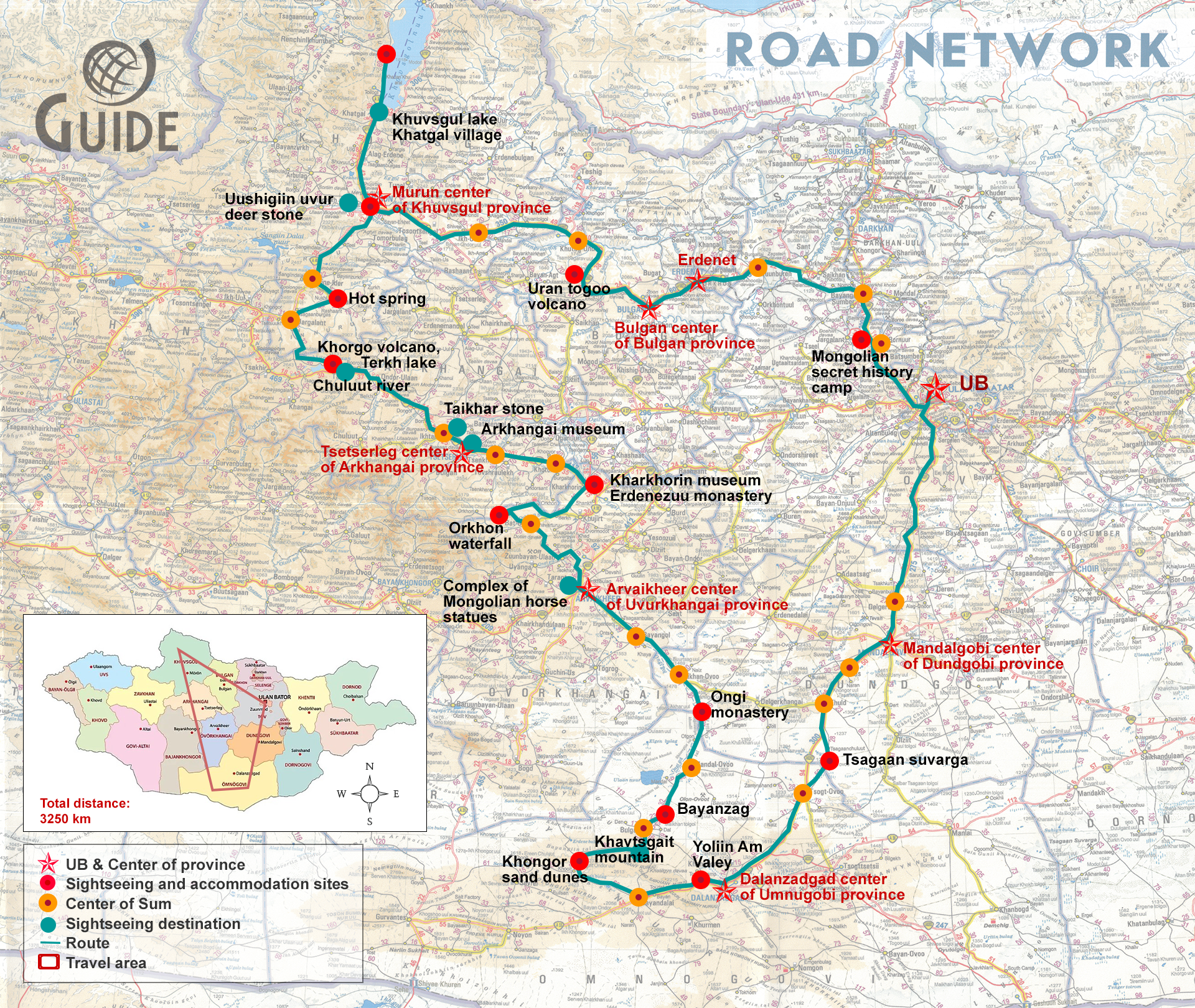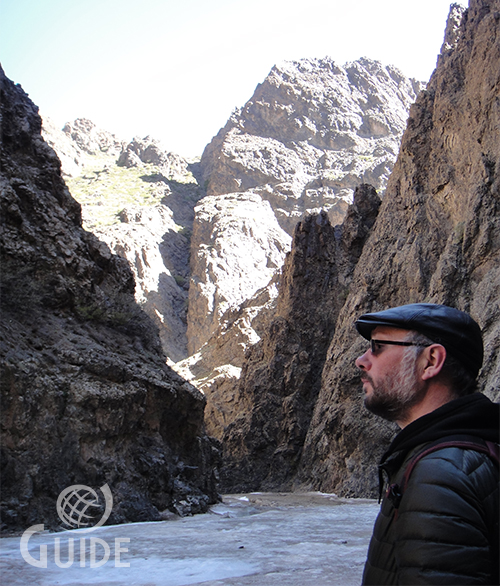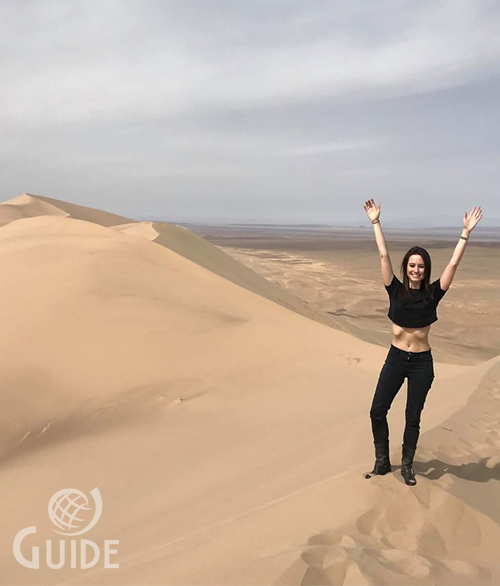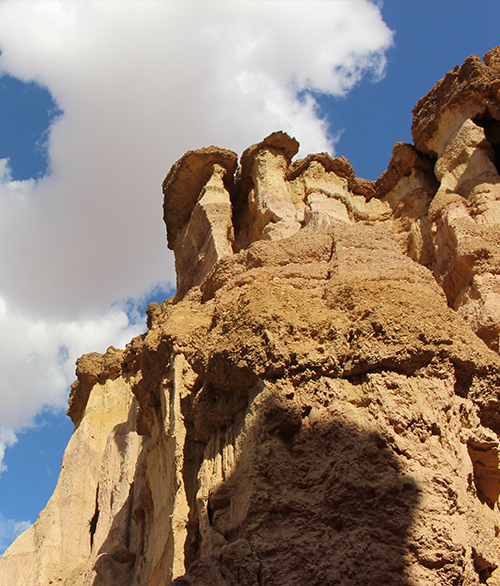Itinerary
DAY 1: Chinggis Khaan Airport – UB (55 km)
Arrival at Chinggis Khaan Airport at Khushig Valley. (Depending on your time of arrival, the city tour will be planned)
Meal: Dinner
Accommodation: Hotel
DAY 2: Mandalgovi – Tsagaan Suvarga (450 km)
Early morning, we drive to the Tsagaan Suvarga, one of the unique places located in the Gobi Desert. We will drive from Ulaanbaatar by 420 km paved road and 30 km unpaved road to this place. The travelers take lunch at Dundgovi province’s center. Once was the ocean bed about 400 million years ago, where the visitors find marine fossils and clamshells, the Tsagaan Suvarga is 30m-60m high and 6000m long colorful limestone formation which can be seen only from its east side. Seeing the Tsagaan Suvarga early morning from its east side and looking from the top during the evening sunset is outstanding and we will experience extraordinary natural scenery.
Meal: Breakfast, Lunch, Dinner
Accommodation: Tourist camp
DAY 3: Yoliin am valley (230 km)
Departing from the Tsagaan Suvarga, upon arrival at Dalanzadgad city, travelers visit the Natural History Museum and take lunch there. Then drive to Yoliin am (Eagle valley or bearded vulture valley) which is located 62 km northwest of Dalanzadgad. Yoliin am is a high rocky gorge named after the Yol bird (Bearded vulture or Lammergeier) and it is located on the east side of the big mountain that stretches 180km and 2800 meters above sea level. We will see the canyon by hiking between the rocky gorges. (If you want, riding a horse or camel 2km until the ending exit of the rocky gorge is an option instead of hiking). Through the corridor of rock walls, it has a small stream from southwest to the northeast that freezes in winter, building up to 8 meters of thick ice. The high rocky gorge’s length is about 8km. We drive between the rock walls and arrive at the tourist camp through the Dungenee pass.
Meal: Breakfast, Lunch, Dinner
Accommodation: Tourist camp
DAY 4: Khongor sand dunes (200 km)
Early morning after breakfast, we drive to Khongor sand dunes. The Khongor sand dunes are one of the major tourist destinations and it is the 3rd biggest in Mongolia. From the Sevrey mountain, south of the sand dunes, it streams a beautiful river and flows below the sand dunes and this Khongor river makes gorgeously green grass on the north side of the sand dunes. Green grass covering land behind yellow sand under blue sky adds perfect harmony to nature. Through the edge of the sand dunes, camel herder families live. These families water their livestock from the river and spend summer pasturing. Here, the travelers will climb up to the Duut mankhan (Singing dunes which is the highest of the sand dunes) and experience inspiring views of the surrounding area and see spectacular Gobi Desert sunrise and sunset.
Meal: Breakfast, Lunch, Dinner
Accommodation: Tourist camp
DAY 5: Khavtsgait Uul mountain petroglyphs – Bayanzag (170 km)
Leaving the Khongor sand dunes, we will drive to the Bayanzag early morning. On the way, 20km from the Bayanzag, we see the rock paintings in the Khavtsgait mountain. Considering the similarity with other rock paintings and their forms and shapes, researchers believed that the Khavtsgait petroglyphs were created about 4000-5000 years ago during the mid and late Bronze Age to early Iron Age. You can see the landmarks of the presentation of several periods of human life. From the top of the Khavtsgait mountain, travelers can see the immensity of the Gobi Desert valleys. Then, we arrive at Bayanzag red sand cliffs where the American famous paleontologist Roy Chapman Andrews expedition was the first to discover dinosaurs’ bones and eggs in the 1920s. Today well known as “flaming cliffs” due to their colors ochre and red, Bayanzag’s discovery has drew the whole world’s attention to the Mongolian Gobi. Also, in the Bayanzag, it was found stone tools from the ancient people’s habitation landmarks which have similar structures that were found in the American Alaska Peninsula.
Meal: Breakfast, Lunch, Dinner
Accommodation: Tourist camp
DAY 6: Ongi Monastery (160 km)
After taking lunch around sunrise, we depart to the Ongi Monastery in the Ongi steppe of Dundgovi province. We arrive at the tourist camp next to the ruins of a large Buddhist monastery that existed 350 years ago. The ruins of the monastery can be seen through the full hillside of the mountain and the river Ongi flows in front of it. Since there are rare water resources in the Gobi region of Mongolia, the Ongi River is an important treasure that sustains the lives of people in the Gobi Desert. After seeing the ruins of the monastery, get to know the history of Mongolian Buddhism and take a good rest at the tourist camp.
Meal: Breakfast, Lunch, Dinner
Accommodation: Tourist camp
DAY 7: Orkhon waterfall (250 km)
On this day, we drive a full day by unpaved road departing from the Gobi region and arriving in the mountainous region. At the end of the road, we drive through a rough uneven rocky road with volcanic rock. We arrive at the waterfall falling into the deep of the ravine hole in middle of the plain ground. The waterfall falls from 24 meters lava cliffs of the Ulaan River which originates from the Khangai mountain range in Central Mongolia. This water flows into the Baikal lake through the two big rivers. We stay in a near tourist camp and take a well rest.
Meal: Breakfast, Lunch, Dinner
Accommodation: Tourist camp
DAY 8: Kharkhorin (120 km)
Early morning, we depart to the Kharkhorin which remains the ruins of the ancient capital which served as the capital of the Mongolian Empire. Firstly, travelers visit the Erdene Zuu Monastery built in 1586. After Ming dynasty troops occupied and later razed the Karakorum, the city could not be rebuilt. The Erdene Zuu Monastery stands near Karakorum and various construction materials were taken from the ruin of Karakorum to build this monastery. After lunch, we visit the Kharkhorin museum and get acquainted with the findings of the city of Karakorum, which were brought out from the latest archeological studies. During the dinner, we enjoy the traditional music concert by local people.
Meal: Breakfast, Lunch, Dinner
Accommodation: Tourist camp
DAY 9: Tsetserleg city - Khorgo volcano crater (310 km)
We arrive in Tsetserleg city which is located in the central part of Mongolia and have lunch there. Moving further, we reach Khorgo mountain and encamp at the tourist camp. It is believed to be the last active volcano in Mongolia that erupted 8,000 years ago. Fresh watered Terkhiin Tsagaan Lake was created from the locked flow of Terkh Rivers by hot lava that flowed out of a mountain crater during a volcanic eruption. Seeing the sunset on the shore of the lake and Khorgo crater, we come to the tourist camp.
Meal: Breakfast, Lunch, Dinner
Accommodation: Tourist camp
DAY 10: Jargal jiguur (130 km)
After taking good rest in the morning, after lunch, we drive to the “Jargal jiguur” tourist camp. Travelers may enjoy the natural hot spring in the pool. It is located on the way to the Khuvsgul. As we head north along the route, the land surface rises slightly, we encounter more foresty mountains, and taller grass, and cross more intermountain valleys vegetated with colorful flowers.
Meal: Breakfast, Lunch, Dinner
Accommodation: Tourist camp
DAY 11: Murun city – Khovsgol lake (250 km)
On this day, we arrive at Lake Khovsgol which is located in the Khoridol Saridag Mountains basin 3200 meters above sea level. Khoridol Saridag Mountains are stretched from south to north and have sharp peaks and deep narrow gorges and valleys originating from tectonic movement cracks. The mountain area is primarily uplifted dolomite with the very barren, arid upland areas contrasting with lower rich alpine meadows. We take lunch in Murun city, which is located at its foothills. Then we drive to the tourist camp through the Jankhai pass.
Meal: Breakfast, Lunch, Dinner
Accommodation: Tourist camp
DAY 12: Uushigiin uvur deer stone complex – Murun (130 km)
The Khovsgol lake originated about 7 million years ago. Its coastline length is 414 kilometers, the second-most voluminous freshwater lake in Asia and 14th in the world. About 46 rivers flow to Khovsgol lake and the lake contains 1% of all the surface fresh water in the world. Almost 70% of the lake area has a depth of more than 100m. The lake is surrounded by several mountain ranges, so the area has late sunrise and early sunset.
On this day, we stay on the shore of the lake and take motorboating. After lunch, we drive to Murun city passing through the Khatgal village. Then we ride to the Uushigiin uvur deer stone complex which is located 16 km west of the Murun. In this sight, there are lots of burial mounds and deer stones in the area and you can explore a line of 14 deer stones placed close to each other. The deer stones date back to the Bronze age and it is considered the representation of the nobility burial culture of the tribal state that existed on the territory of Mongolia.
Meal: Breakfast, Lunch, Dinner
Accommodation: Hotel
DAY 13: Uran togoo extinct volcano (300 km)
We depart the Murun through the northern region road heading to Ulaanbaatar. We arrive at the tourist camp near the Uran togoo extinct volcano. It is believed to have been extinct 25,000 years ago, and the top of the mountain is intact and not cracked. Uran means "Artistic" and Mongols named it so because ridge of the crater is like a nice creature of a craftsman when we see from the distance. Circle-shaped ridge about 400 m across that contains a crater deep 100m.
Meal: Breakfast, Lunch, Dinner
Accommodation: Tent
DAY 14: Erdenet city- Mongolian Secret History tourist camp (410 km)
We arrive and take lunch in Erdenet city which is the second largest and most populated city after Ulaanbaatar. The city was founded in 1973, and was built with the establishment of a factory using a large copper deposit called "Erdenetiin Ovoo". Young workers from all over Mongolia came and settled in Erdenet, and the city developed rapidly. Erdenet is located 381km from Ulaanbaatar. Erdenet plant, which produces copper concentrate, provided 30-40% of Mongolia's budget during the socialist period, and today still has an important role on the Mongolian economy. Then we depart Erdenet city the Mongolian secret history tourist camp and take a rest.
Meal: Breakfast, Lunch, Dinner
Accommodation: Tourist camp
DAY 15: Ulaanbaatar (110 km)
Early morning, we drive to Ulaanbaatar. Travelers will visit the center of Ulaanbaatar and do shopping in the souvenir shops and markets. Take time to prepare for the home return flight.
Meal: Breakfast, Lunch, Dinner
Accommodation: Hotel
DAY 16: UB - Chinggis Khaan Airport (55 km)
Take a return flight to the respective country from the Chinggis Khaan Airport.
Meal: Breakfast










